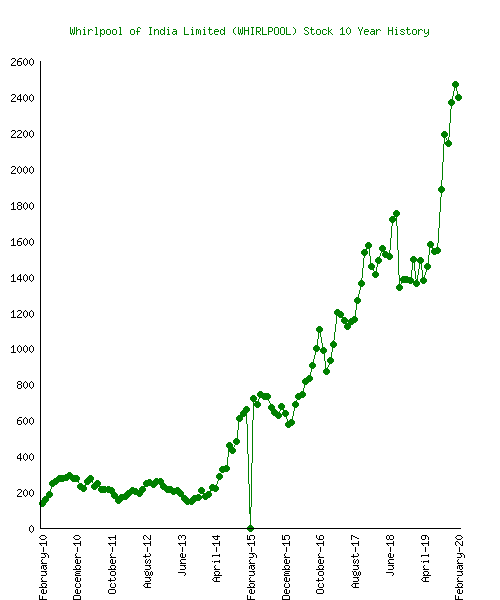The Indian arm of America’s consumer durable giant was showing sluggish progress at the beginning of this decade. Whirlpool was doing great until the advent of this century. With the arrival of the 21st century, the Asian brands entered the field, posing as tough competitors. Both in India and globally, Whirlpool was having a tough time, incurring notable losses. The chairman of Whirlpool India, Arvind Uppal joined the company after bidding adieu to Nestle. Uppal joined a little later in 2005, and the company was in huge losses. Uppal noticed that the morale of the employees was down, hampering their productivity. Competition from Asia has pushed the morale of the company in the red. Uppal’s first and foremost step towards success was to boost the employee morale and pay attention to strength, consumers and the product.
Uppal strategy included a constant focus on home appliances like washing machines, refrigerators, microwaves and air conditioners. Whirlpool also entered the water solutions and high-end kitchen solutions. With the turning of the new century, the women started playing a major role in decision making about their homes. Uppal analyzed that the business strategy and the product innovation are targeted towards the women who were the evolving buyers in this segment. In 2007, in an interview with Economic Times, Arvind Uppal said “We have been making operating profits and hopefully this year we would end with a net profit. The bulk of the gains would come from improving our position in the refrigerator market while also increasing our sales in fast-growing categories like air conditioners. We are looking at an overall growth of 20-25% in sales this year.”

Since 2008, Whirlpool has been targeting to dominate the fabric dryer market for higher-income households. The washing machines have limited capacity when it comes to drying, but the company promised to go a step further and introduced an advanced drying technology and fully automated washing machines. With foreign brands coming in, Whirlpool India did not sit back but fought back with innovative products and attractive advertisements. In 2016-2017, Whirlpool India was expected to witness massive growth with its launching of new models of washing machines and refrigerators in Kerala. Its annual turnover in 2017 reached Rs 4400 crores. From 2017 to 2018, the sales rose to 14.41% and touched 5072.55 crores, and the net profit increased at a rate of 13% and reached 350.67 crores.
By initiating a supply chain turnaround in Whirlpool India, the company could reduce costs and increase net profit. In the year 2000, the condition of the supply chain proved to jeopardize the sales of the products; the products would not reach the consumers even though they were stocked in inventory, only 87% of the products were available to the customers. The then introduced ERP failed terribly, previously 70,000 products were delivered daily, but post-ERP implementation the number reduced to 2,000. The company started benchmarking the competition; it targeted the areas which required less investment to gain higher supremacy. By 2017, it has already reached majority of tier II and III cities. The price brackets and product rangers are diverse, giving the consumers a large number of options to choose from.
Whirlpool India worked hard to build and shape the Future of Work. It identified the consumers, the socio-economic conditions, the future operating scenarios of various industries, and the upcoming technological trends. The company applies a systematic approach for planning involving various departments and domains. CPFR-Collaborative Planning, Forecasting and Replenishment is a web-based tool used for forecasting and completing the projects, the database being used by both Whirlpool and its traders.
Whirlpool India is focussing predominantly in product portfolio and distribution and has set a target to reach $1 billion by 2020. It has plans to expand aggressively, launching new products every two months. The company has identified three sectors in which there is the scope of improvements, air, water and cooking. The refrigerators and washing machines are the signature products of this brand. But exploring newer avenues will work as a catalyst in the process of steady business expansion. Higher disposable income rates, rural electrification, rapid urbanization and digitization hint at the company’s growth potential. The first time users of the semi-urban and rural areas are inclined to buying the entry-level products, while the existing users will upgrade to premium ranges of products.
The increase in the GDP per capita income has triggered the demand for electronic appliances, and this is the reason why the company has increased the number of distributors and new retail points. The company has already initiated the plans for expanding manufacturing facilities in places like Pondicherry and Pune. The previous MD of Whirlpool Mr Sunil D’ Souza said to Hindu Business Line in 2018, “In the air-conditioners segment, we have launched a wide range of new products this year with features such as humidity control and air purification. We are focusing on gaining a significant share in the AC segment.”
The technological advancement is not overlooked by this consumer durable giant. The IoT enabled appliances can rule this sector and Whirlpool is taking the matter in close consideration. The company is launching new products, creating a buzz among the consumers successfully, manufacturing products for the price-sensitive tech-savvy evolving consumers and always eager to explore the unexplored.
The company, under the able hands of wise leaders, managing directors and executives is progressing in the right direction. The failure faced during the initial years of this century is converted to a success story. The budding entrepreneurs, soloprenuers and business owners can learn a great deal from the turnaround story of Whirlpool.

- Know your competitors well: The company was well aware of the tough competition from the Asian manufacturers. The company did not back down but geared up with new products, heightened employee morale and product innovation. When the company witnessed low morale and enthusiasm among the staff, it focussed that and thus increased the growth potential. The company is implementing technological advancements for better user experience, thus retaining the position in the market.
- Supply Chain turnaround helps in increasing growth potential: The company modified the business strategies, reduced costs and increased the profit. The distribution process is made simple and cost-efficient for healthy business operations.
- Set a target and plan to reach it: Setting a target and plan a method to reach it. Setting unattainable targets and then moving into depression is not the best thing to do. Whirlpool India has set a target to reach $1 billion by 2020, and it is working to reach it. Launching new and varieties of products frequently, penetrating in the semi-urban and rural sectors are some of the methods implemented by the company to reach the set target.
Mistakes and failures are great teachers, but wouldn’t be great if you can avoid them on time? Google will give you hundreds of websites, but an expert will guide you thoroughly in your journey. Do you want to talk to experts in detail? Talk to our niche skilled experts now to know the diverse competitive market in greater detail! We at Vedak have an exclusive pool of experienced industry professionals and veterans who have in-depth knowledge about the business nitty-gritty. Contact us to know more.

